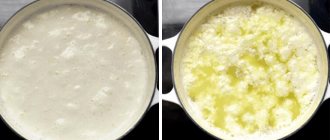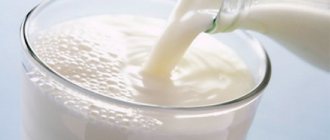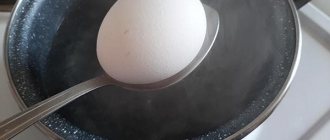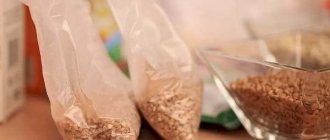Cow's milk is a very common product that is beneficial for children and adults.
It is indispensable for preparing confectionery and bakery products. It is a common belief that the healthiest milk is sold on the market. However, pathogenic microorganisms that are dangerous to human health quickly multiply in fresh drinks. Therefore, milk must be boiled before drinking. This will protect you from many diseases that are transmitted from cows. Boiled cow's milk is absolutely safe. Thanks to heat treatment, all pathogenic bacteria die in a few minutes. The most important thing is to boil milk correctly so that it turns out tasty and healthy. To do this, you need to find out the cooking time, recommended dishes, and so on.
Do I need to boil milk bought at the store?
Some people don’t understand why boil the drink before drinking. Doctors advise thermally processing even farm milk that was purchased from trusted suppliers.
Meanwhile, people in rural areas often consume raw milk. But during milking, dangerous bacteria from the cow's udder can enter the product. They multiply quickly in the drink, since this environment is the most favorable for them. Brucellosis and tuberculosis are transmitted from sick animals. In addition, raw milk contains female sex hormones. To be safe, be sure to boil the drink.
A common question is: should you boil pasteurized milk from the store? During the production of the drink, pasteurization is carried out, this is called heat treatment. It destroys all harmful microorganisms. Therefore, you can drink store-bought milk without fear. The only exception is when preparing dishes that require the addition of warm milk. In this case, the drink should not be boiled, it just needs to be heated.
Why do this?
By raising a cow yourself and properly caring for it, you don’t have to worry about drinking fresh milk. But when buying from other farmers, you need to play it safe and take into account the boiling procedure.
The reasons why you should definitely boil your homemade product are as follows.
- Possibility of transmitting diseases to animals. As a result of this fact, dangerous microorganisms can also get into milk. Improper cow care leads to the same result.
- The product may contain antibiotics. There is a possibility that they were fed to the animal to prevent disease.
- Due to the content of lactic acid bacteria, fresh milk can turn sour immediately on the day of milking.
- The person who milked the animal may not have adhered to the established rules for the procedure.
- The storage and transportation of goods may have been carried out without observing sanitary standards.
When boiling, the following elements disappear:
- pathogenic bacteria from the skin of a cow, a milkman or from the air (the boiling process helps kill brucellosis, for example);
- lactic acid bacteria, which are necessary for fermentation (but thanks to this fact, the product is stored longer);
- enzymes that allow young children to digest formula (adults can get them from fermented milk products);
- vitamin C and some others, which are not very resistant to heat treatment (but there are very few such components in the initial product);
- immunoglobulins needed only by calves.
But at the same time, the product retains:
- calcium is the most important and useful component;
- a significant proportion of vitamins and microelements;
- fats and milk protein.
Despite all these facts, even a glass of boiled milk or regular store milk contains a small amount of antibiotics that are resistant to high temperatures, which are added to animal feed in industrial production.
How to boil milk correctly
To prepare a tasty and safe product, you need to know how to boil milk correctly. In industrial conditions, the drink is heated to a high temperature of 75–80 degrees for half an hour. Such heat treatment is difficult to carry out at home due to the lack of equipment. Therefore, the best way is to bring the product to a boil.
- Fill the pan halfway with cold milk.
- Place on low heat.
- Stir constantly with a spoon, otherwise the milk will burn.
- Once foam appears, turn the heat to very low.
- Cook for 1 – 2 minutes.
- Remove container from heat. Cool.
- It is best to place the pan in a bowl of cold water.
Many people ask how long to boil milk. The time depends on the type of product. Pasteurized milk just needs to be put on fire and brought to a boil. Raw milk is boiled for 2-3 minutes. It is constantly stirred to avoid burning. It is not recommended to boil milk for too long, as beneficial nutrients are lost over time.
Foam may appear on the surface of the drink, which contains many useful substances. Do not skim and throw away the foam; it is best to stir the milk well.
Helpful advice! Take only a clean container. Milk quickly absorbs odors, so it is best to have a separate container for preparing it.
Sometimes you only need to make a glass of milk - for example, for baby food. It is inconvenient to use a large container for this. A microwave oven will solve the problem. It is important to keep a few tips in mind:
- The microwave oven heats the drink unevenly. Therefore, you will have to boil the milk in 3 stages - 20 seconds each. After each stage, take out the glass and mix its contents well.
- Fill the glass 2/3 full. When heated, the drink expands.
- Place a wooden stick in the milk to allow steam to rise.
The nutritional value
The nutritional value of boiled milk is quite high. It contains macro- and microelements: potassium, calcium and phosphorus. The drink is also rich in two dozen milk enzymes, such as amylase, lactose, lipase, phosphatase, etc. There are vitamins, proteins (casein, lactoglobulin, lactalbumin) and milk sugar in the form of carbohydrates.
Boiling neutralizes pathogens in the drink, but also partially destroys vitamins and precipitates proteins. Boiled milk contains:
3.4 g protein; . 1-4 g fat;
100 ml of boiled milk contains the following vitamins and minerals:
The benefits and harms of boiled milk
Boiling milk kills pathogenic bacteria, thereby extending the shelf life of the drink.
This product can be stored in the refrigerator for up to one week, but it is important not to close the container tightly, otherwise the product will suffocate and turn sour faster.
Many people are interested in whether boiled milk is healthy. The answer is definitely positive, since the drink contains various vitamins and microelements that support the functioning of the body and prevent various diseases.
When milk is boiled, beneficial bacteria and enzymes die, which help the product to be more easily digested. For example, heat treatment destroys vitamins A, C, B12 and D, and calcium and phosphorus take on a form that is not absorbed by the human body. Lactoferrin, which is responsible for the absorption of iron and protein from milk, also dies.
Due to the loss of beneficial substances, milk is more difficult to absorb by the body, and some of them are retained in it and have a negative effect on the liver, so this drink should not be abused.
How much to drink?
You can avoid all the harmful consequences and get the benefits of boiled milk by following the norm. According to some sources, the daily norm for drinking the drink is no more than 1 liter per day. This amount contains the maximum amount of nutrients that the body is able to absorb.
As for pregnant women, they are recommended to drink milk, as a product containing calcium, every day, but a maximum of 1-2 glasses. For people over 50 years of age, it is better to avoid regular consumption of the drink, as it becomes more difficult for the body to digest it. Many people use boiled milk for coughs, adding honey and other beneficial ingredients to it.
Modern technologies make it possible to produce products with a very long shelf life. For example, pasteurized milk can sit in the refrigerator for weeks and remain fresh. Because it was processed in a way that killed both harmful and beneficial bacteria. That is why more and more housewives are striving to buy natural milk for their families on the market. But for it to be safe, it must be heat treated. How to boil milk correctly to preserve nutrients?
What to do if milk burns
Even experienced housewives are faced with burning milk. The reason for this is protein folding at high temperatures. This substance sticks to the inner surfaces of the container. But there are ways to solve the problem. First of all, use suitable utensils. Enamel and ceramic pans are not suitable because protein easily sticks to these materials. It is best to use glass, aluminum and metal containers.
Choose a thick-walled container with a double bottom to ensure even heating of the contents. If there is no such dish, place an inverted dish on the bottom. It is not recommended to fill the container more than 2/3 - otherwise the milk will run away.
Note! Do not close the lid. While the milk is boiling, you need to constantly monitor and stir it.
Some useful tips:
- Pour some water into the bowl. Bring to a boil. The water will evaporate and prevent the milk from burning.
- Grease the sides of the container with butter.
- A multicooker is well suited for boiling milk. It ensures even heating of the bowl.
Burnt milk can be saved. To do this, pour the drink into a separate container and pass through cheesecloth several times. Add a little salt, stir well. To cool quickly, place the container in a bowl filled with cold water. An additional way is to add crackers wrapped in cheesecloth. It will absorb the unpleasant odor.
Suitable cookware
Milk tends to burn. In order to avoid this fact, you need to choose the right dishes.
- in an aluminum pan;
- in glass containers;
- in a stainless steel container.
It is not recommended to carry out the process with a boiler, as this will form a large layer of scale, and the milk around the device will burn. It is also better to take dishes with a thick bottom. It is strictly forbidden to heat milk in enamel containers.
Cleaning a pan from burnt milk
If a drink burns while boiling, it must be cleaned immediately. Fill the container with cool water. Add baking soda and scrub off any remaining burnt residue with a brush. By the way, instead of soda, other cleaning substances are suitable - today manufacturers produce a wide variety of household chemicals for dishes. It all depends on the material of your container.
- If there is a brown coating left on the walls of the stainless pan, add water and boil for 1.5 hours along with soda. Add 1 pack of soda to 5 liters of water.
- An enamel pan is cleaned in a different way - pour 5 tbsp. spoons of soda and add warm water. Leave to infuse overnight.
- You can use activated carbon for cleaning. Crush the tablet and sprinkle the powder onto the stain. Leave for half an hour. Then brush over.
- If the pan is aluminum, pour in table vinegar and leave to steep for a couple of hours with the lid closed. Remove the stain with a sponge.
- You can make your own cleaning product. Dissolve 20 g of grated laundry soap, 90 g of chalk and 30 g of ammonia in 60 g of water.
Why might milk run away?
Another common problem when boiling milk. The drink begins to foam strongly and leaves the pan. You have to wash the stove and possibly the floor.
The cause of the problem is the formation of air bubbles. For example, when water boils, they rise from the bottom and burst on the surface. However, milk contains a lot of proteins and fats that prevent the bubbles from bursting.
A dense film appears on the surface, under which air accumulates. During heating, the bubbles become much larger. Thick foam appears. After a few seconds, the drink leaves the pan.
Is it possible to prevent milk from escaping? There are some useful tips:
- Place a metal disk or an upside down dish on the bottom of the container.
- Stir the product constantly - then a film will not appear.
- Lubricate the walls with oil.
- Use cookware with high sides. Pour milk until halfway.
The fifth secret is sweet.
Place a piece of sugar in a saucepan with milk and boil under the lid. Stir the milk periodically, which avoids problems when boiling. Stirring should be done every three minutes.
Active government intervention in market relations cannot be limited solely to protecting domestic producers from foreign competitors. Sooner or later it will begin to establish barriers in the domestic market.
Rosselkhoznadzor and its head Sergei Dankvert, who became famous for their bans on the import of Turkish tomatoes and Belarusian dairy products, finally caused a stir in the domestic dairy market. On February 1, the supervisory agency began assigning statuses to individual subjects of the Federation based on danger from the point of view of animal diseases. As a result, for 25 Russian regions, including Tatarstan and the Rostov region, a ban on the export of raw milk outside the region came into force. Tatarstan, which produces 5.7% of Russian milk, was particularly affected. For the dairy industry, this turned out to be far from the most pleasant surprise, since the industry is already suffering from a shortage and rising prices for raw materials. “Due to the closure of supplies from Tatarstan and the Rostov region, a sharp shortage of milk may indeed arise; it is already observed. There is no longer enough natural milk at the moment - without any resolution from Rosselkhoznadzor,” said Vasily Boyko-Veliky, founder of the Russian Milk agricultural holding.
A sharp exchange of public demarches began.
The National Union), which, in particular, includes PepsiCo and Danone, sent a warning letter to the Minister of Agriculture Alexander Tkachev that this measure will lead to an increase in prices for dairy products. “Diseases need to be fought, but not in such a way as to untimely ban something or install additional pasteurization on the farm,” said Maria Zhebit, director of the Soyuzmolok public relations department, noting that pasteurization is carried out in factories, and livestock farmers receive equipment it is often unaffordable for her.
If the Ministry of Agriculture, represented by the head of the department for regulating agricultural markets, Vladimir Volik, simply denied the possibility of a rise in milk prices, then the reaction of Rosselkhoznadzor turned out to be disproportionately harsh: the department’s statement even said that Soyuzmoloko was trying to discredit the entire executive branch. Sergei Dankvert said that the union’s statement “will destabilize the situation in the dairy and consumer markets.”
At the same time, Rosselkhoznadzor tried to shift responsibility for the possible rise in prices to Soyuzmoloko, sending a request to the FAS to check the situation with prices.
Rosselkhoznadzor spokeswoman Yulia Melano said that it is possible that Soyuzmolok participants entered into a cartel conspiracy.
The situation is becoming especially nervous also because it is unfolding against the backdrop of a conflict with Belarus, whose agricultural products have also been subject to restrictions. In Belarus they even opened a criminal case against Sergei Dankvert. The latter publicly hinted that Soyuzmoloko often relies on the opinions of foreign, in particular Belarusian, processors. State Duma deputy from Tatarstan Airat Khairullin suggested that Rosselkhoznadzor’s decision is politically motivated, and he is trying to demonstrate to Belarus that requirements within Russia are also becoming stricter. Chairman of the Board of the International Confederation of Consumer Societies Dmitry Yanin believes that Rosselkhoznadzor is fighting for additional powers, including with Rospotrebnadzor.
It is obvious that prices for dairy products will rise, and all that remains is to find the culprits.
Why does milk curdle when boiled?
pixabay.com If the product curdles during cooking, then its freshness is in doubt.
To check the freshness of milk, it is not necessary to boil it completely. Fill a small container with 2 or 3 tablespoons of drinking water and place on fire. Once it starts boiling, add a little milk. If it begins to curdle, do not boil the rest. It is best to use a fermented product. To prevent curdling of fresh milk, add a little water. If the milk has curdled before cooking, there is no need to throw it away either. You can prepare various fermented milk products from it:
- Boil the mixture for 3 minutes. Place on gauze. You will get homemade cottage cheese.
- If you put the cottage cheese under a press, you will get cheese.
- The remaining liquid is called serum. It is suitable for baking pancakes.
If you bought too much milk, prepare condensed milk. To do this, put 2 cups of sugar per 1 liter. Cook for 3 – 4 hours over low heat.
The benefits of boiled milk
The product is completely safe and is well suited for baby food. Boiled milk contains many vitamins, microelements, and proteins. It is used to relieve intoxication in the body. However, it is widely believed that heat treatment destroys lactobacilli. Therefore, the product is poorly absorbed.
However, it has useful properties:
- Positively affects the cardiovascular system.
- Improves liver and kidney function.
- Does not contain dangerous cholesterol.
- It has a rich composition.
- Reduces nervous tension.
If cow's milk is processed correctly, it will only bring benefits.











